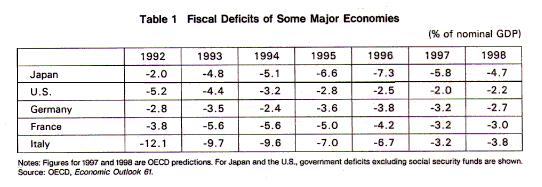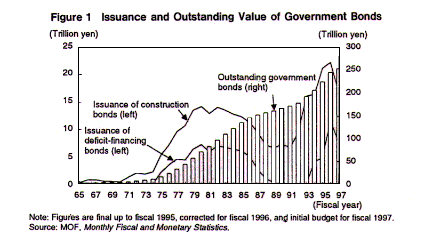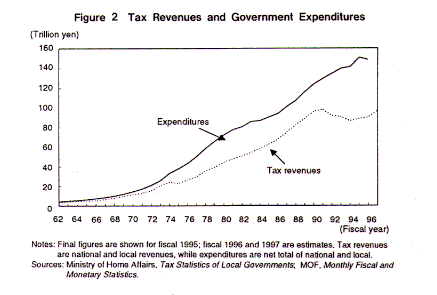- NLI Research Institute >
- The Urgency of Fiscal Structure Reform in Japan
The Urgency of Fiscal Structure Reform in Japan
Koichi Haji
Font size
- S
- M
- L
1. Status of Public Finances
(1) Japan
Fiscal 1997 has been designated as the first year of fiscal reconstruction. Due to the consumption tax hike to 5 percent and termination of the special income tax cut begun in fiscal 1994, the government is issuing fewer bonds than in fiscal 1996, albeit still a hefty total of 16.7 trillion yen. By the end of fiscal 1997, the total value of outstanding government bonds will reach 254 trillion yen (approximately $2.1 trillion), roughly 50 percent of nominal GDP.
Balance sheets are also deteriorating at local government levels, whose outstanding loans are estimated at 150 trillion yen ($1.25 trillion). According to the OECD, in 1996 the government sector's aggregate budget deficit reached approximately 7 percent of nominal GDP, one of the worst figures among the industrialized nations.
(2) Fiscal Reforms in Europe and the U.S.
All industrialized economies have in common the problem of fiscal deficits. The U.S. has been plagued by twin deficits as the shortage of domestic savings causes the fiscal deficit to spill over into the trade deficit. However, helped by the boost to tax revenues from the strong economy, the fiscal deficit has shrunk rapidly during the Clinton administration, falling from $290 billion in 1992 to what the OMB predicts will be $37.3 billion in fiscal 1997.
In Europe, participation in the single currency requires all countries to converge with regard to inflation and other economic conditions. Countries must bring their deficit-to-nominal-GDP ratio under 3 percent, and debt-to-GDP ratio below 60 percent. While countries with relatively small deficits such as France and Germany are apprehensive about meeting the deficit target, Italy and other countries with large deficits have slashed their deficits markedly.

2. History of Fiscal Reform
(1) The Oil Crises as a Turning Point
Immediately after World War II, Japan's economy suffered from a shortage of goods due to loss of production capacity, inflation from the massive amount of government bonds issued during the war, and large fiscal deficits. But the economy recovered under the fiscal austerity imposed by the Dodge Plan. In the period of rapid growth, while public sector demand expanded along with the economy, public finances remained sound as rising incomes and corporate profits boosted tax revenues enough to allow income tax cuts almost every year.

These fiscal conditions changed considerably after the first oil shock. When oil prices soared, economic growth and tax revenue growth declined. Meanwhile, since fiscal 1973, when the government first turned its attention to welfare, pension benefits were being expanded significantly under the Tanaka Cabinet, while social insurance expenditures rose sharply due to the aging population. By fiscal 1975, the government's finances had deteriorated to the point that deficit-covering bonds had to be issued.
(2) Fiscal and Administrative Reforms in the 1980s
After the proportion of bond issues in general account revenues (bond dependence) rose in fiscal 1979 to a high of 34.7 percent, administrative and fiscal reforms were pursued in the 1980s. From fiscal 1983 to 1987, the fiscal balance gradually improved as growth of the general account was restrained. One of the major results of administrative reform during this time was the privatization and breakup of the heavily indebted national railways.

Following the Plaza Accord in late 1985, the yen rose against the dollar from the ¥200 range to the ¥100 range, leading to a recession. But then came the bubble economy era at the end of 1986. As land and stock prices rose, corporate profits surged, tax revenues from corporate and securities transaction taxes rose, and the fiscal deficit fell rapidly. Furthermore, the government introduced the consumption tax in fiscal 1989, and achieved its fiscal 1990 target of ending deficit-financing bond issues for the general account. Local governments posted budget surpluses on the whole.
However, since this deficit reduction had come not from fiscal reforms but from the bubble economy's higher tax revenues, when the bubble peaked in 1991 and turned into a recession, land and stock prices fell, tax revenues fell, and the fiscal deficit began expanding again. Furthermore, to alleviate the severity of the bubble's collapse, a series of large stimulus packages were implemented beginning in August 1992. In fiscal 1994 a 6-trillion yen tax cut was implemented for income and residential taxes, further reducing tax revenues and making Japan's fiscal deficit the worst among the industrialized nations.
3. Fiscal Reconstruction Issues
(1) Legislation for Fiscal Structure Reform
The government's basic policies for fiscal reform are contained in the "Five Principles of Fiscal Structure Reform" approved in March 1997. The final report of the Conference on Fiscal Structure Reform approved on June 3 contains spending reduction targets in major budget categories such as social security, public works outlays, education and defense. This report will form the backbone of legislation tentatively called the Fiscal Reconsolidation Law.
Five Principles of Fiscal Structure Reform
|
Looking abroad, we see that the Omnibus Budget Reduction Act (OBR 90, 93) in the U.S. has discretionary spending caps, while France's five-year fiscal plan establishes fiscal deficit targets as a ratio to GDP. Enactment of a fiscal structure reform law in Japan would have a similar effect of restraining the deficit.
(2) Evaluation of Fiscal Reconstruction Targets
The objective of fiscal reconstruction during the 1980s was to cease issuing deficit-covering bonds. The present five principles for fiscal structure reform go further in two aspects: they will lead to reforms encompassing local governments as well, and will prevent deceptive accounting practices in the deficit and limit the issuance of construction bonds.
One reason for the failure of past reform attempts has been their exclusive focus on the central government's general account budget. Although the final expenditures of local governments greatly are much larger than the general account budget, the central government has been indifferent toward local fiscal reform until now. The new targets are expected to give momentum to fiscal reform at the local level.

Another aspect of the problem has been the government's complicated accounting system, which has allowed superficial progress to be made in deficit reduction without any substantive progress. Through these manipulations, bond issues were ostensibly curtailed, while the actual debt accumulated as the government's "hidden debt" has grown to an estimated 45 trillion yen as of the end of fiscal 1997. In addition, the lack of limits on the issuance of construction bonds has created constant pressure to increase public works spending in annual budgets as well as in economic stimulus packages. The adoption of an overall target defined by the ratio of fiscal deficit to nominal GDP renders the superficial deficit reductions meaningless, and also serves to limit the issuance of construction bonds.
4. Unresolved Issues
(1) Population Aging and Fiscal Reform
With the aging of society, to maintain pensions and medical insurance under the social security system in the 21st century, the public's share of these burdens will have to rise. In the Health Ministry's "Welfare Vision for the 21st Century" of 1994, the public's burden in fiscal 1993 was divided into a social security component (17.8 percent) and other component (20.8 percent), and the social security component was predicted to rise to approximately 30 percent by 2025. It is now clear that this prediction was overly optimistic, and that the public will have to bear an even greater portion of the burden as the society ages.

However, there is a problem in linking this growing public burden as the society ages with the present fiscal deficit problem, and then trying to solve the fiscal structure reform simply by increasing the public's burden. Fiscal reform must distinguish the social security component, which will inevitably increase due to aging, from the rest. Even without raising the non-social-security burden, the public's share of 38 percent in fiscal 1993 will increase to approximately 50 percent by fiscal 2025. Such a huge burden threatens to reduce the work motivation of the labor force, and to compound the problem by leading to economic stagnation and declining revenues from taxes and social insurance premiums. To alleviate the vicious cycle triggered by aging and growing public burdens, the fiscal deficit problem needs to be resolved without resorting to increasing the public's burden.
(2) Interrelated Nature of Reforms
Fiscal structure reform cannot succeed if attempted singly; it needs to be carried forward in tandem with the government's six-part general reform. The fiscal reconstruction of the 1980s failed because it did not go far enough in reforming the scope of government work, deregulation, redefining the relationship between national and local governments, and curtailing expenditures − as a result, the fiscal balance deteriorated when tax revenues fell. In this sense, achieving a small government through administrative reform is inextricably linked to pursuing economic structural reform centered around deregulation and fiscal structural reform. Structural reform in social security will inevitably have a significant impact on future fiscal budgets. Moreover, what is known as the secondary budget−the fiscal loan and investment program − is closely linked to reform of the financial system in both procuring funds and extending loans.
Six Major Reforms
|
If fiscal reform reduces government spending, the negative impact on the economy will be unavoidable. The economy may then slump, thereby reducing tax revenues by more than the spending cuts and leaving the deficit intact, or causing Japan's external surplus to grow. To avoid these problems, fiscal reform must be carried out while at the same time pursuing reforms on the economic structure such as administrative reform and deregulation, and encouraging business investment.
Since the reforms in the government's six-part reform program are all interrelated, pursuing one particular reform will not yield satisfactory results. For fiscal structure reform to succeed, all six of the reforms will need to be pushed forward as a whole.
Koichi Haji
Research field
レポート紹介
-
研究領域
-
経済
-
金融・為替
-
資産運用・資産形成
-
年金
-
社会保障制度
-
保険
-
不動産
-
経営・ビジネス
-
暮らし
-
ジェロントロジー(高齢社会総合研究)
-
医療・介護・健康・ヘルスケア
-
政策提言
-
-
注目テーマ・キーワード
-
統計・指標・重要イベント
-
媒体
- アクセスランキング

















